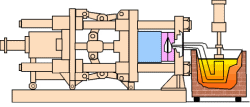MORE EFFICIENCY IN ELECTRICAL PARTS. A great quantity of small and medium sized parts made up of most electrical and electronic equipment are created out of zinc. These zinc die casting parts are accepted choices in the production several of electrical and electronic equipment. Zinc parts possesses strength and hardness not always present in parts that are plastic molded, sand casted, permanent mold casted, forged, stamped, and screw machined. Zinc material advantages chiefly in the electrical industry are resistant to high temperature and have superior electrical properties.
These zinc die casting parts are able both in terms of expenditure and functionality. Cost efficiency is one of the zinc material advantages because zinc parts can be manufactured in one single piece of several workings. This eradicates the necessary assembly later or for additional fastening implements. Also, this results in more resilient parts that rely more on the strength of its alloy to a certain extent than in the strength of the fastening material used or the way the parts are melded together. The durability of the zinc die casting parts spells their effectiveness in terms of their use and function.
Zinc die casting parts also have excellent shielding properties that allow it to function in inner circuits as an electrical ground. These parts have high thermal conductivity that makes them fitting choices for electronic connectors as well as tiny components in consumer electrical and electronics equipment. The positive benefit of the zinc die casting parts’ finishing versatility also allows for wear resistance in when used as exterior parts of various gears. These zinc material advantages make zinc die casting parts an competent choice in most electronic and electrical applications.
Die Casting Zinc Company Blog gives information on how to get a zinc die casting part for manufacturers. If you are looking for Die Casting Zinc Parts or if you need Miniature Zinc Die Casting Parts will give you more information you can use for manufacturing.


